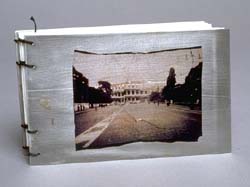
C
OPTIC AND
C
OLLAGE
Ancient Technique, Modern Application
A Survey of contemporary implementations of the first binding
structures.
Curated by Zahra Partovi
CENTER FOR BOOK ARTS April 12 - June 14, 1997

| In an effort to express his ideas and preserve them in a written language, man has taken many giant steps in the art of bookmaking. One such crucial step was the advent of the sewn book developed around the first century A.D. Following the refinement of this great discovery, we arrive at several monasteries scattered around Northern Egypt. It was here that the monks of the Coptic Church perfected the sewing structure and the protective covers of their codex to what we know today as Coptic Binding. |
The present exhibition and accompanying catalogue pay homage to those
early bookmakers who introduced this important technique to the art of
the book, a technique which was to become the model for all other book
structures to come, and whose integrity of style and diversity of
application have preserved a lasting presence in its original form until
today. Using the works of scholars, book artists and student, this
catalogue surveys the Coptic structure from a historical perspective and
examines its contemporary application for artistic expression.
The exhibition features historical examples including four facsimile
Coptic wrappers and an original writing box from the 1910 Hamuli
excavation, on loan from the Pierpont Morgan Library, providing insights
to the Early Christian era in North Africa. Handwoven Egyptian textiles
and mats; an unfinished book (as if the binder had taken a rest from his
work); and traditional binder's tools will also be on display.
The artist books in the exhibition provide a surprising contrast to
the ancient artifacts, even though all the contemporary books in the
exhibit utilize the same ancient bookmaking technique. Vibrant and
colorful, the artists reveal a mastery of technique using unusual
materials, such as plastic, steel or wood. They expose the spine of their
books with beautiful chain stitches typical of Coptic binding.
Whether it is Mary Ellen Long's leather cowboy boot split in half and
chain stitched together as covers, or a book by Ted Kurahara with classic
wooden covers, this exhibit binds history and artistry together,
revealing works worthy of the Coptic art's momentous past.
Participating artists include Shana Agid, Judith Brindley, Jin Kyoung
Chang, Gerard Charriere, Katherine D. Crone, Elsi Vassdal Ellis, Gary
& Cecilia Frost, Lisa Goldenberg, Susannah Hays, Joan Iversen Goswell,
Midori Kunikata-Cockram, Ted Kurahara, Mary Ellen Long, Mary Ellen
Matthews, Denise Mullen, Maria Pisano, Kristin Sherwood, Keith Smith,
Reginald Walker and Susan Weil.
Zahra Partovi, the curator of this exhibition, is a translator and
bookbinder. She has recently completed a translation of Divan-E-Shams, a
selection from the work of 13th century Persian poet Jalaluddin Mohammad
Rumi. Ms. Partovi is the Production Associate at Vincent FitzGerald & Co.
in Manhattan and teaches Coptic Binding at the Center for Book Arts.
|
ENTER EXHIBIT |
BACK TO COLOPHON GALLERY |